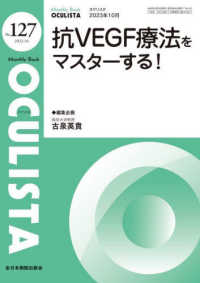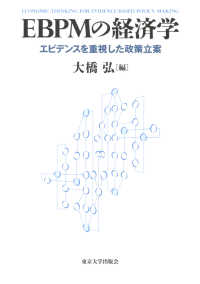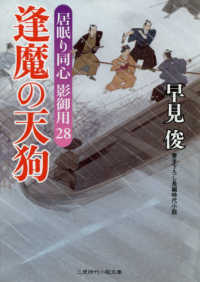- ホーム
- > 洋書
- > 英文書
- > Science / Mathematics
Full Description
In These Pages You Will Learn from 60 Years of Intense Experience Putting Out Fires
Fire stream management can be defined as the systematic application of water streams to a fire for the purpose of extinguishment. Managing fire streams considers the following points:
Flow rate
Reach and penetration of the stream
Form of water discharge
Water supply
Safety
Integration with other functions, such as ventilation
This book focuses on the essentials: water movement and application of water for structural firefighting. It addresses and explains that basic aspect of firefighting that most of us thought we mastered early in our careers. Reason tells us something must be amiss since we continue to burn firefighters as well as buildings despite what is believed to be aggressive attack tactics.
Let's start here, at square one. The techniques and procedures outlined in this book have been effectively developed and used in actual fire combat throughout author David P. Fornell's more than 60 years in the fire service. If you have ever dragged a line down a blistering, living-hell hallway only to be pushed back by fire lapping over your stream, you need to know why it happened and how to prevent it in the future. A good hydraulics book will tell you how to make fire streams. This book will tell you how to effectively and safely use them.
Contents
Foreword by Andrew O'Donnell
Acknowledgments
Introduction
1 Fire Stream Basics
Basic Hydraulics
Introduction To Water Movement
Factors Affecting Friction Loss
Water Movement Terms
Fire Pump Operations
Onboard Water Tank Operations
Drafting
Supply Line Hydraulics
Forward Lay Supply Operations
Determining Supply Line Hose Sizes
Ways of Increasing Supply Line Flows
Laying Additional Lines
Increasing Hoseline Diameter
Increasing Pressure to Increase Flow
Combining Procedures
Managing Water Supplies
Get Water Out of the Pump
Factors Affecting Water Movement
Simplifying Water Delivery Calculations
A Brief Review
Chapter 1 Review Questions
2 Strategic Considerations
Setting Goals
Legal Challenges
Extinguishing More Fire with Fewer Personnel
Response District Evaluation
How Much Flow Do You Apply?
Personnel Requirements
Establishing Flow Rates
Fire Flow Formulas
Individual Line Flows
Unwritten Planning
Evaluating Rates of Flow and Areas of Application
Evaluation of Line Sizes
Reaching the Fire
High-Volume Handlines
High-Rise Buildings
Review
Chapter 2 Review Questions
3 Nozzle Theory
Basic Methods
Direct Attack Method
Indirect Attack Method
Indirect Attack Theory
Iowa Research
Evaluating Indirect Attack Tactics
Underwriters Laboratories Fire Safety Research Institute Research
Stream Selection for Penetration
Life Safety During Firefighting Operations
Other Testing
Indirect Approach Applications
Development Of Sensible Tactics
Preventing and Mitigating the Effects of Flashover
Chapter 3 Review Questions
4 Nozzle Basics
Basic Nozzle Design
Nozzle Components
Nozzle Types
Nozzle Basics
World War II
The Early Days of Fog for Structural Use
Stream Pattern Control
Controlling Gallonage
Shutoff Devices
Flush Features
Teeth
Protection Myth
Combination Nozzle Types
Using the Adjustable Gallonage Nozzle in Place of the Automatic Nozzle
Distributor and Piercing Nozzles
Opposed Discharge Nozzle
Bent Discharge Nozzle
High-Pressure Delivery
Conserving Water versus Extinguishing the Fire
Fog Pressure Apparatus in Chicago
Modern Experience with High-Pressure Delivery
U.S. Air Force High-Pressure Operation
Chapter 4 Review Questions
5 Automatic Nozzles
Automatic Nozzle Design
High-End Performance
The Automatic Nozzle's Ability to Increase Flow
Automatic Nozzle Operation at Lower Flows
Utilizing Automatics
Automatic Nozzle Master Stream Operation
Handline Operation Using Automatic Nozzles
High-Pressure/Maximum Volume Method of Operation
Fixed-Gallonage Method of Operation
Predetermined Pressure Method of Operation
Nozzle Evaluation
Handline Nozzle Reaction
Automatic Nozzle Flow Ranges
Pump Operation for Automatic Nozzles
Operational Hints
Attempting To Evaluate Amount of Flow
Chapter 5 Review Questions
6 Smoothbore Nozzles
Nozzle Comparison
Smoothbore Nozzle Tips
Effect of Tip Size Selection
Smoothbore Firefighting Tactics
The Smoothbore Nozzle's Operational Advantages
Penetration
Managing Unwanted Steam
Smoothbore Nozzle Use with Standpipes
Reducing Stress
Training
Combination Stream Attack
Twin Tips
Threaded Tip Styles
Variations on Common Smoothbore Nozzles
Conclusion
Chapter 6 Review Questions
7 Low-Pressure Nozzles
High-Flow Handlines
The History of Low-Pressure Combination Nozzles
The Low-Pressure Age Begins
Safety In Handling
Low-Pressure Nozzle Evaluations
Converting Present Nozzles
Explanation of Nozzle Reaction Forces
Review
Chapter 7 Review Questions
8 Heavy Streams
Heavy Stream Equipment
Combination Aerial and Pumper Apparatus
Heavy Stream Nozzles
Using Heavy Streams Effectively
Blitz Attack Tactics
Mounting
Large Fire Combat Tactics
Staging Area
Considering the Effectiveness of Smoothbore Streams
Ground-Attack Monitors
Fighting a Losing Battle
Protecting Exposures
Directing Heavy Streams
Heavy Stream Safety
Chapter 8 Review Questions
9 Fire Hose Basics
Hose Construction
Fire Hose Yarns
Fire Hose Sizes
Fire Hose Pressure Ratings
Countering the Effects of Heat and Wear
Rubber-Covered Hose
Other Methods of Protecting Hose
Forestry Hose
A Discussion About Lightweight Lined Hose
Hose for High-Rise Use
Large-Diameter Hose
Large-Diameter Flow Systems
Inspection and Maintenance
Chapter 9 Review Questions
10 Class A Foam
History
Development of a Suitable Agent
What Are Class A Agents?
Putting Class A Agents to Work
Premix or Batch Mixing
Discharge-Side Eductors and Proportioners
Balanced- and Positive-Pressure Injection Metering Systems
Compressed Air Injection
Using Class A Extinguishing Agents for Structural Firefighting
Increasing Firefighter Safety by Using Class A Agents
Class A Agents on Class B Fires
The Future of Class A Agents
Chapter 10 Review Questions
11 Tactical Fire Attack
Engine Company Size-Up
The Art of Applying the Water
Ventilation
Overhaul
Water Damage
What Happens When Unwanted Steam Is Generated?
Preventing Fire Spread by Stream Placement
Ventilation in Conjunction with Engine Work
Consider Water Supply
Summary
Chapter 11 Review Questions
12 Managing Hose
Attack Line Hose Loads
Preconnected Beds
Bulk Hosebeds
Reverse Lays
Forward Lays
Flying Lay
Handling the Line
Summary
Chapter 12 Review Questions
13 Evaluation and Maintenance
Nozzle Operation Review
Performing Evaluations
Equipment For Evaluation
Purchasing Equipment
Pricing Factors
Nozzle Maintenance
Maintenance Procedures
Repair Parts
Chapter 13 Review Questions
Answers for Chapter Review Questions
Index
About the Author







